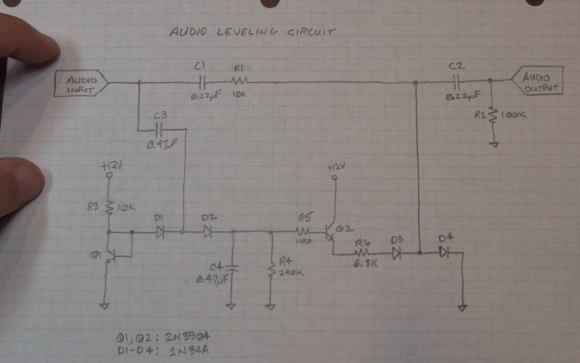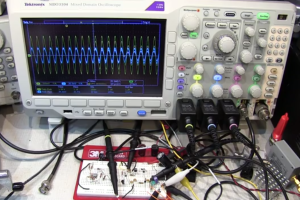
[Alan’s] friend came to him with a problem. He loved listening to his scanner, but hated the volume differences between stations. Some transmitters would be very low volume, others would nearly blow his speakers. To solve the problem, [Alan] built up a quick automatic leveling circuit (YouTube link) from parts he had around the lab.
[Alan’s] c ircuit isn’t new, he states right in the video that various audio limiting, compressing, and automatic gain control circuits have been passed around the internet for years. What he’s brought to the table is his usual flair for explaining the circuits’ operation, with plenty of examples using the oscilloscope. (For those that don’t know, when [Alan] isn’t building circuits for fun, he’s an RF applications engineer at Tektronix).
ircuit isn’t new, he states right in the video that various audio limiting, compressing, and automatic gain control circuits have been passed around the internet for years. What he’s brought to the table is his usual flair for explaining the circuits’ operation, with plenty of examples using the oscilloscope. (For those that don’t know, when [Alan] isn’t building circuits for fun, he’s an RF applications engineer at Tektronix).
Alan’s circuit is essentially an attenuator. It takes speaker level audio in (exactly what you’d have in a desktop scanner) and outputs a limited signal at about 50mv peak to peak, which is enough to drive an auxiliary amplifier. The attenuator is made up of a resistor and a pair of 1N34A Germanium diodes. The more bias current applied to the diodes, the more they will attenuate the main audio signal. The diode bias current is created by a transistor-based peak detector circuit driven off the main audio signal.
But don’t just take our word for it, watch the video after the break.














This audio AGC looks simple enough to implement in homebrew receivers. Nice.
very cool; for comparison what would the DSP equivalent of this circuit look like?
Probably have a DAC feeding into a DSP, with them connected to power and ground, and some sort of output. Don’t forget the clock crystal!
I’ve wanted to try something like this for a while. Will any type of cap do? Would the audio signal coming out be good enough to put inline with a TV?
I think he said the output was about 50mv so you’d need about 20X amplification to get up to line level audio which is about 1v. Also, this circuit requires a speaker level input so you’d need a preamplifier on the front end as well.
Certainly doable with a couple opamps. I also thought about applying it to TV audio also to overcome the stupidly wide dynamic range common in movie now.
I just ran the scanner out thru attenuator and into a dictation type cassette recorder. Set it on record. Plugging in a speaker into the recorders output gives back the monitor at power. No amp needed. One mod in the the recorders board is a smaller cap on the time constant for quicker recovery. Find it by probing for a cap that the voltage changes up and down on when you shout in the mike and let it get quiet. Another mod undoes the volume control bypass in record giving control back to monitor level.
Space station Mir came thru loud and clear daily!
Hey, look at that! My video’s on Hack a Day! Thanks for sharing it Adam!
how does it work with actual audio though? you only showed us operation on a single tone… audio and speech is very complex and I have a feeling your ac coupling will be filtering out some important frequencies
It actually works quite well on actual audio. Amplitude is controlled in proportion to voice/audio peaks. Frequency response is flat from a few hundred Hz to well beyond the audible range .
Follow-up video – listen to the results on an actual scanner…
http://www.youtube.com/watch?v=pUii_pDQxg8
Is there any possibility of a circuit diagram? I would really like to build one of these compressors. With the new narrow band rules, levels are all over the place as some agencies have implemented narrow band and some have not.
Many Thanks
Gary Morgan
There is a link in the video notes on YouTube:
https://m.youtube.com/watch?v=1h0FZJYXQ_w
#157 & #163 both follow fairly simple designs.
Both have ‘just as many flaws;
please keep in mind that “these are designed to specifically handle the situation addressed” only.
Engineering and Designing are useful for specific purposes.
JW USAF Retired.
hmm, old telephone rules might apply here. 300 hz to 3,000 hz band passing filters should clean up the Narrow Band problem. Now apply either stablizer mentioned and you should be compliant to almost all Federal mandates. Engineers automatically assume you already know what the standards ARE.
HI, thanks for posting. I’m interested because I’m designing a light control unit. Can I use this circuit for the analog conditioning of a signal coming from a mixer? Of course then I’ll need some sort of amplification to feed the 0-3.3V ADC I’m using to get filters’ samples.
Hi Adam,
We run a lodge, and I have all my cd’s on my hard drive.
The sound from CD to CD is unpleasant.
Your box requires the same input / output as my computer 2 way speaker system.
Do you sell these boxes ???
I would want one.
Please let me know.
Thanks
Regards
Will